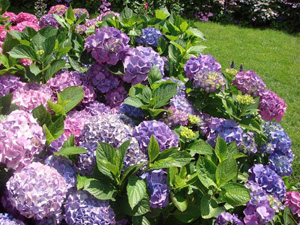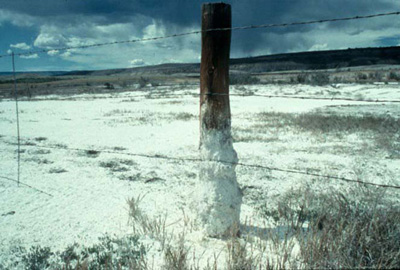
Soil Chemical Properties
This flower is a hydrangea. Under certain soil conditions, it will flower pink, but under other soil conditions it will flower blue. What makes the difference? Poke around the internet and see if you can find out.
This flower completely relies on a chemical property of soil to determine which color the flowers will be. Did you find out which property makes the difference? Read through each property to find out.
Soil Fertility

Fertility describes the ability of a soil to provide the nutrients necessary for good plant growth. If the soil does not naturally contain all the nutrients that a crop needs, then fertilizer is added to soil to give it a boost. The corn plant on the left is obviously not as healthy as the one on the right. Which one do you think was fertilized?
Soils naturally vary in their fertility. This has a lot to do with the parent material of the soils and the degree to which the soils are weathered. Soils derived from limestone are generally more fertile than those derived from sandstone, because limestone contains more of the chemical elements that make important plant nutrients. Highly weathered soils can also be less fertile than moderately weathered soils because high levels of weathering can leach (take away) all the soil nutrients out of the soil.
Salinity

It looks like snow, but the white stuff on the ground in this picture is really salt. Some soils have high-salt content. In arid areas, the salt is left behind to accumulate on the ground after soils dry out and lose their surface water. Alternatively, salt is sometimes accidentally added to soil with irrigation water if rainfall is not sufficient in an area. The measure of the salt content in soil is called soil salinity. Salinity is harmful to the soil, since most plants and soil organisms are killed by excessive salt build-up.
Soil pH

The pH of a substance is a measure of how acidic the substance is. Many items can be described in terms of their relative acidity. Common substances can range in pH from 0 (zero) to 14. A pH value from 0 to 7 is considered acidic, with the smaller numbers being more acidic than the larger ones. A value of 7 is considered neutral, and values between 7 and 14 are non-acidic, or basic.
Most agricultural soils have a pH value between 5 and 7. If a soil has a pH below that it, is usually considered too acidic; if it has a pH above 7, it is considered too alkaline. Some crops, such as blueberries, do better in slightly more acidic conditions. Basic (also called alkaline) soils are most common in dry, arid climates. Soil pH affects how nutrients are available in soil, because some chemical elements that make plant nutrients are only available to plant roots under a given range of pH conditions. Soil pH is usually considered the most important chemical property in terms of nutrient availability—and can affect things like flower color.
Soil pH also plays a role in fertility, because it determines whether or not nutrients can be taken up by plant roots. For example, the nutrient, iron, is highly affected by soil pH. At pH values above 8, roots cannot absorb iron and the plant becomes iron deficient.